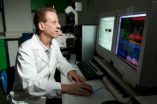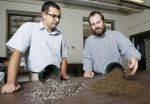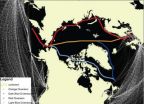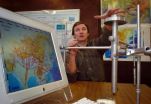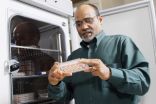Heat acclimation benefits athletic performance
Health-related and performance benefits found among cyclists pre-training in Oregon's climate chamber
2010-10-26
(Press-News.org) Turning up the heat might be the best thing for athletes competing in cool weather, according to a new study by human physiology researchers at the University of Oregon.
Published in the October issue of the Journal of Applied Physiology, the paper examined the impact of heat acclimation to improve athletic performance in hot and cool environments.
Researchers conducted exercise tests on 12 highly trained cyclists -- 10 males and two females -- before and after a 10-day heat acclimation program. Participants underwent physiological and performance tests under both hot and cool conditions. A separate control group of eight highly trained cyclists underwent testing and followed the same exercise regime in a cool environment.
The data concluded that heat acclimation exposure provided considerable ergogenic benefits in cool conditions, in addition to the expected performance benefits in the hot environment. The study is the first to evaluate impacts of heat acclimation on aerobic performance in cool conditions.
"Our findings could have significant impacts in the competitive sports world," said Santiago Lorenzo, a researcher who performed the work as part of his dissertation at the University of Oregon. He is now completing post-doctoral training in the Institute for Exercise and Environmental Medicine (University of Texas Southwestern Medical Center) at Texas Health Presbyterian Hospital Dallas.
The study found performance increases of approximately 7 percent after 10 heat acclimation exposures. "In terms of competitive cycling, 7 percent is a really big increase and could mean that cyclists could use this approach to improve their performance in cooler weather conditions," said Lorenzo. However, the heat exposures must be in addition to the athletes' normal training regimen.
Heat acclimation improves the body's ability to control body temperature, improves sweating and increases blood flow through the skin, and expands blood volume allowing the heart to pump to more blood to muscles, organs and the skin as needed.
Another approach using the environment to improve exercise performance is a "live high/train low" regimen, which means residing at a high altitude and training at a low altitude. Many athletes worldwide now use this approach. According to Lorenzo, "heat acclimation is more practical, easier to apply and may yield more robust physiological adaptations."
The study was conducted in the Evonuk Environmental Physiology Core lab at the UO department of human physiology. The climatic chamber was set at 38 degrees Celsius (100 degrees Fahrenheit) for heat testing and 13 degrees Celsius (55 degrees Fahrenheit) for cool conditions with consistent humidity (30 percent relative humidity) for the cyclists' exercise tests.
According to Christopher Minson, co-director of the Evonuk lab, head of the UO human physiology department and study co-author, researchers also concluded that the heat may produce changes in the exercising muscle, including enzymatic changes that could improve the amount of work done by the muscle, but he says future research will have to examine it further.
"A next step is to determine whether heat acclimation improves performance in a competitive or real-world setting," said Minson.
He also notes possible implications for people with cardiac or other limitations such as paralysis that don't allow for the full cardiovascular benefits of exercise. If heat can be added, "it's conceivable that they would gain further cardiovascular benefits than exercise alone in a cool environment. These are exciting questions that deserve further study," said Minson.
INFORMATION:
Additional co-authors include John Halliwill, UO human physiology, and Michael Sawka of Thermal and Mountain Medicine Division, U.S. Army Research Institute of Environmental Medicine. The research was funded by a grant from the Eugene and Clarissa Evonuk Memorial Fellowship and an ongoing grant to Minson from the National Institutes of Health.
About the University of Oregon
The University of Oregon is a world-class teaching and research institution and Oregon's flagship public university. The UO is a member of the Association of American Universities (AAU), an organization made up of the 63 leading public and private research institutions in the United States and Canada. The University of Oregon is one of only two AAU members in the Pacific Northwest.
Sources: Santiago Lorenzo, 214-345-6504, santitracker@hotmail.com; Christopher Minson, 541-346-4105, minson@uoregon.edu
Links:
Minson faculty page: http://pages.uoregon.edu/hphy/people/faculty_bio_minson.php
Department of Human Physiology: http://pages.uoregon.edu/hphy/entry/welcome.php
Evonuk Environmental Physiology Core: http://eeplabs.uoregon.edu/
ON FACEBOOK: http://www.facebook.com/UniversityOfOregonScience
ELSE PRESS RELEASES FROM THIS DATE:
2010-10-26
HOUSTON, Oct. 25, 2010 – Some unexpected effects of lead exposure that may one day help prevent and reverse blindness have been uncovered by a University of Houston (UH) professor and his team.
Donald A. Fox, a professor of vision sciences in UH's College of Optometry (UHCO), described his team's findings in a paper titled "Low-Level Gestational Lead Exposure Increases Retinal Progenitor Cell Proliferation and Rod Photoreceptor and Bipolar Cell Neurogenesis in Mice," published recently online in Environmental Health Perspectives and soon to be published in the print ...
2010-10-26
WEST LAFAYETTE, Ind. - Greenhouse plant growers can substitute rice hulls for perlite in their media without the need for an increase in growth regulators, according to a Purdue University study.
Growing media for ornamental plants often consists of a soilless mix of peat and perlite, a processed mineral used to increase drainage. Growers also regularly use plant-growth regulators to ensure consistent and desired plant characteristics such as height to meet market demands. Organic substitutes for perlite like tree bark have proven difficult because they absorb the plant-growth ...
2010-10-26
As the ice-capped Arctic Ocean warms, ship traffic will increase at the top of the world. And if the sea ice continues to decline, a new route connecting international trading partners may emerge -- but not without significant repercussions to climate, according to a U.S. and Canadian research team that includes a University of Delaware scientist.
Growing Arctic ship traffic will bring with it air pollution that has the potential to accelerate climate change in the world's northern reaches. And it's more than a greenhouse gas problem -- engine exhaust particles could ...
2010-10-26
GAINESVILLE, Fla. — New University of Florida research puts to rest the mystery of where old carbon was stored during the last glacial period. It turns out it ended up in the icy waters of the Southern Ocean near Antarctica.
The findings have implications for modern-day global warming, said Ellen Martin, a UF geological sciences professor and an author of the paper, which is published in this week's journal Nature Geoscience.
"It helps us understand how the carbon cycle works, which is important for understanding future global warming scenarios," she said. "Ultimately, ...
2010-10-26
WEST LAFAYETTE, Ind. - Researchers found a previously unmapped fault was responsible for the devastating Jan. 12 earthquake in Haiti and that the originally blamed fault remains ready to produce a large earthquake.
Eric Calais, a Purdue University professor of earth and atmospheric sciences, led the team that was the first on the ground in Haiti after the magnitude 7.0 earthquake, which killed more than 200,000 people and left 1.5 million homeless.
The team determined the earthquake's origin is a previously unmapped fault, which they named the LÄogëne fault. The newly ...
2010-10-26
CHICAGO, Oct. 25, 2010 – Young children who consume substantial amounts of fluoride through infant formula and other beverages mixed with fluoridated water or by swallowing fluoride toothpaste have an increased chance of developing mild enamel fluorosis, according to research published in the October issue of The Journal of the American Dental Association and supported by the National Institute of Dental and Craniofacial Research. Children can continue using fluoridated water and fluoride toothpaste because fluoride has been proven to prevent tooth decay, and mild fluorosis ...
2010-10-26
While most commonly associated with mononucleosis, Epstein-Barr virus (EBV) has been linked to many diseases that affect people long after the initial infection takes place, including some forms of cancer. In the current issue of the Journal of Biological Chemistry, scientists at The Wistar Institute describe how viral microRNA – small segments of RNA that suppress the effects of gene activity – allows EBV to hide within cells and evade the immune system. The scientists believe their findings may one day enable physicians to flush EBV out of hiding, allowing a healthy immune ...
2010-10-26
CAMBRIDGE, Mass. -- Researchers at MIT have revealed exactly how a molecule called fulvalene diruthenium, which was discovered in 1996, works to store and release heat on demand. This understanding, reported in a paper published on Oct. 20 in the journal Angewandte Chemie, should make it possible to find similar chemicals based on more abundant, less expensive materials than ruthenium, and this could form the basis of a rechargeable battery to store heat rather than electricity.
The molecule undergoes a structural transformation when it absorbs sunlight, putting it into ...
2010-10-26
WEST LAFAYETTE, Ind. - Pathogenic listeria tricks intestinal cells into helping it pass through those cells to make people ill, and, if that doesn't work, the bacteria simply goes around the cells, according to a Purdue University study.
Arun Bhunia, a professor of food science, and Kristin Burkholder, a former Purdue graduate student who is now a postdoctoral researcher in microbiology and immunology at the University of Michigan Medical School, found that listeria, even in low doses, somehow triggers intestinal cells to express a new protein, heat shock protein 60, ...
2010-10-26
An international team of researchers based at the Institute of Vertebrate Paleontology and Paleoanthropology in Beijing, including a physical anthropology professor at Washington University in St. Louis, has discovered well-dated human fossils in southern China that markedly change anthropologists perceptions of the emergence of modern humans in the eastern Old World.
The research was published Oct. 25 in the online early edition of the Proceedings of the National Academy of Sciences.
The discovery of early modern human fossil remains in the Zhirendong (Zhiren Cave) ...
LAST 30 PRESS RELEASES:
[Press-News.org] Heat acclimation benefits athletic performance
Health-related and performance benefits found among cyclists pre-training in Oregon's climate chamber
